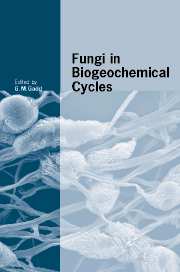Book contents
- Frontmatter
- Contents
- List of Contributors
- Preface
- 1 Geomicrobiology: relative roles of bacteria and fungi as geomicrobial agents
- 2 Integrated nutrient cycles in boreal forest ecosystems – the role of mycorrhizal fungi
- 3 Fungal roles in transport processes in soils
- 4 Water dynamics of mycorrhizas in arid soils
- 5 Integrating ectomycorrhizal fungi into quantitative frameworks of forest carbon and nitrogen cycling
- 6 Role of arbuscular mycorrhizal fungi in carbon and nutrient cycling in grassland
- 7 The role of wood decay fungi in the carbon and nitrogen dynamics of the forest floor
- 8 Relative roles of bacteria and fungi in polycyclic aromatic hydrocarbon biodegradation and bioremediation of contaminated soils
- 9 Biodegradation and biodeterioration of man-made polymeric materials
- 10 Fungal dissolution and transformation of minerals: significance for nutrient and metal mobility
- 11 Fungal activities in subaerial rock-inhabiting microbial communities
- 12 The oxalate–carbonate pathway in soil carbon storage: the role of fungi and oxalotrophic bacteria
- 13 Mineral tunnelling by fungi
- 14 Mineral dissolution by ectomycorrhizal fungi
- 15 Lichen biogeochemistry
- 16 Fungi in subterranean environments
- 17 The role of fungi in carbon and nitrogen cycles in freshwater ecosystems
- 18 Biogeochemical roles of fungi in marine and estuarine habitats
- Index
- References
5 - Integrating ectomycorrhizal fungi into quantitative frameworks of forest carbon and nitrogen cycling
Published online by Cambridge University Press: 10 December 2009
- Frontmatter
- Contents
- List of Contributors
- Preface
- 1 Geomicrobiology: relative roles of bacteria and fungi as geomicrobial agents
- 2 Integrated nutrient cycles in boreal forest ecosystems – the role of mycorrhizal fungi
- 3 Fungal roles in transport processes in soils
- 4 Water dynamics of mycorrhizas in arid soils
- 5 Integrating ectomycorrhizal fungi into quantitative frameworks of forest carbon and nitrogen cycling
- 6 Role of arbuscular mycorrhizal fungi in carbon and nutrient cycling in grassland
- 7 The role of wood decay fungi in the carbon and nitrogen dynamics of the forest floor
- 8 Relative roles of bacteria and fungi in polycyclic aromatic hydrocarbon biodegradation and bioremediation of contaminated soils
- 9 Biodegradation and biodeterioration of man-made polymeric materials
- 10 Fungal dissolution and transformation of minerals: significance for nutrient and metal mobility
- 11 Fungal activities in subaerial rock-inhabiting microbial communities
- 12 The oxalate–carbonate pathway in soil carbon storage: the role of fungi and oxalotrophic bacteria
- 13 Mineral tunnelling by fungi
- 14 Mineral dissolution by ectomycorrhizal fungi
- 15 Lichen biogeochemistry
- 16 Fungi in subterranean environments
- 17 The role of fungi in carbon and nitrogen cycles in freshwater ecosystems
- 18 Biogeochemical roles of fungi in marine and estuarine habitats
- Index
- References
Summary
Introduction
Ecosystem ecologists have calculated carbon and nitrogen budgets for a variety of forest ecosystems. Despite a growing awareness of the importance of mycorrhizal fungi in nitrogen uptake, as carbon sinks for photosynthate and as conduits for carbon from plants to the below-ground community, few ecosystem ecologists have incorporated mycorrhizal fungi in their conceptual models of how forests function. Longstanding difficulties in assessing the presence and quantity of mycorrhizal fungi in soil, in identifying mycorrhizal fungi to species, and in assessing the mycorrhizal role in carbon and nitrogen cycling, have probably limited the willingness and ability of ecosystem ecologists to incorporate mycorrhizal fungi into their research. In particular, ecosystem models have not yet included mycorrhizal fungi, despite the key role of mycorrhizal fungi at the interface of plants, the soil and microbial communities below-ground.
In this review we will focus on ectomycorrhizal fungi that form symbioses with many of the dominant trees of temperate and boreal forests, particularly in trees of the Pinaceae, Fagaceae, Betulaceae and Salicaceae. Ectomycorrhizal fungi also form symbioses with many tropical trees, including the Dipterocarpaceae of southeast Asia and Eucalyptus of Australia. We will lay out the current state of knowledge of the functioning of ectomycorrhizal fungi in carbon and nitrogen cycling of forest ecosystems as inferred from field and laboratory studies. Finally, we will discuss progress in integrating mycorrhizal fungi into quantitative frameworks of forest ecosystem function.
- Type
- Chapter
- Information
- Fungi in Biogeochemical Cycles , pp. 98 - 128Publisher: Cambridge University PressPrint publication year: 2006
References
- 6
- Cited by



